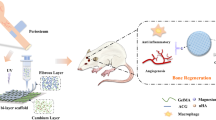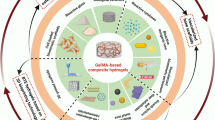Abstract
Vascularization on newly implanted metal orthopedic implants has remained a challenge in the field of tissue engineering. To address this challenge, in this research, an interconnected foam structure of Ti-6Al-4V was microfabricated by electron beam melting (EBM) technique. The foam in question has a density of 1.77 g cm−3 with 60% porosity and a tensile strength of 18 GPa. An extracellular matrix based hydrogel was added as an aqueous matrix to the foam. Hypoxia mimetic stress has been closely related to many wound healing biomedical applications as it increases survival and proliferation molecular signals. To that end, increased expression of hypoxia-inducible factor-1α (Hif-1α) and vascular endothelial growth factor (VEGF) in the aqueous hydrogel matrix was achieved by the addition of a hypoxia mimetic deferoxamine mesylate (DFM). In this study, the formation of an endothelial network was achieved in a hydrogel matrix in the presence of the before mentioned 3D printed metal foam. Cellular viability, fluorescent microscopy and scanning electron microscopy imaging analysis demonstrate that pre-osteoblasts undergo proliferation and also attach efficiently to the foam when exposed to DFM. Human umbilical vascular endothelial cells (HUVECs) were grown in an extracellular matrix-like 3D hydrogel and a hypoxia-like stress was achieved. This research demonstrates that pre-osteoblast cells undergo cell differentiation and increase the production of hydroxyapatite on exposure to the hypoxia mimetic molecule. This proposed approach encompasses an ideal prototype for a completely living implanted structure for future orthopedic implants.
Similar content being viewed by others
References
Kang HW, Lee SJ, Ko IK, et al. A 3D bioprinting system to produce human-scale tissue constructs with structural integrity. Nat Biotechnol, 2016, 34: 312–319
Chung IM, Enemchukwu NO, Khaja SD, et al. Bioadhesive hydrogel microenvironments to modulate epithelial morphogenesis. Biomaterials, 2008, 29: 2637–2645
Nicodemus GD, Bryant SJ. Cell encapsulation in biodegradable hydrogels for tissue engineering applications. Tissue Eng Part BRev, 2008, 14: 149–165
Nguyen LH, Annabi N, Nikkhah M, et al. Vascularized bone tissue engineering: approaches for potential improvement. Tissue Eng Part B-Rev, 2012, 18: 363–382
Bertassoni LE, Cecconi M, Manoharan V, et al. Hydrogel bioprinted microchannel networks for vascularization of tissue en-gineering constructs. Lab Chip, 2014, 14: 2202–2211
Zhang X, Yan X, Cheng L, et al. Wound healing improvement with PHD-2 silenced fibroblasts in diabetic mice. PLoS ONE, 2013, 8: e84548
Samelko L, Caicedo MS, Lim SJ, et al. Cobalt-alloy implant debris induce HIF-1α hypoxia associated responses: a mechanism for metal-specific orthopedic implant failure. PLoS ONE, 2013, 8: e67127
Unger RE, Dohle E, Kirkpatrick CJ. Improving vascularization of engineered bone through the generation of pro-angiogenic effects in co-culture systems. Adv Drug Deliver Rev, 2015, 94: 116–125
Jung HD, Jang TS, Wang L, et al. Novel strategy for mechanically tunable and bioactive metal implants. Biomaterials, 2015, 37: 49–61
Sobral JM, Caridade SG, Sousa RA, et al. Three-dimensional plotted scaffolds with controlled pore size gradients: effect of scaffold geometry on mechanical performance and cell seeding efficiency. Acta Biomater, 2011, 7: 1009–1018
Phelps EA, Headen DM, Taylor WR, et al. Vasculogenic bio-synthetic hydrogel for enhancement of pancreatic islet engraftment and function in type 1 diabetes. Biomaterials, 2013, 34: 4602–4611
Kusumbe AP, Ramasamy SK, Adams RH. Coupling of angiogenesis and osteogenesis by a specific vessel subtype in bone. Nature, 2014, 507: 323–328
Novosel EC, Kleinhans C, Kluger PJ. Vascularization is the key challenge in tissue engineering. Adv Drug Deliver Rev, 2011, 63: 300–311
Snyder CM, Chandel NS. Mitochondrial regulation of cell survival and death during low-oxygen conditions. Antioxidants Redox Signal, 2009, 11: 2673–2683
Alvarez-Tejado M, Naranjo-Suarez S, Jiménez C, et al. Hypoxia induces the activation of the phosphatidylinositol 3-Kinase/Akt cell survival pathway in PC12 cells. J Biol Chem, 2001, 276: 22368–22374
Chen LL, Huang M, Tan JY, et al. PI3K/AKT pathway involvement in the osteogenic effects of osteoclast culture supernatants on preosteoblast cells. Tissue Eng Part A, 2013, 19: 2226–2232
Liu P, He K, Song H, et al. Deferoxamine-induced increase in the intracellular iron levels in highly aggressive breast cancer cells leads to increased cell migration by enhancing TNF-α-dependent NF-κB signaling and TGF-β signaling. J Inorg Biochem, 2016, 160: 40–48
Zhang Y, Zhao X, Chang Y, et al. Calcium channel blockers ameliorate iron overload-associated hepatic fibrosis by altering iron transport and stellate cell apoptosis. Toxicol Appl Pharmacol, 2016, 301: 50–60
Xie W, Lorenz S, Dolder S, et al. Extracellular iron is a modulator of the differentiation of osteoclast lineage cells. Calcif Tissue Int, 2016, 98: 275–283
Kontoghiorghe CN, Kontoghiorghes GJ. Efficacy and safety of iron-chelation therapy with deferoxamine, deferiprone, and deferasirox for the treatment of iron-loaded patients with nontransfusion-dependent thalassemia syndromes. Drug Des Devel Ther, 2016, 10: 465–481
Guo JP, Pan JX, Xiong L, et al. Iron chelation inhibits osteoclastic differentiation in vitro and in Tg2576 mouse model of Alzheimer’s disease. PLoS ONE, 2015, 10: e0139395
Stegen S, van Gastel N, Eelen G, et al. HIF-1α promotes glutaminemediated redox homeostasis and glycogen-dependent bioenergetics to support postimplantation bone cell survival. Cell Metabolism, 2016, 23: 265–279
Selvaraju V, Parinandi NL, Adluri RS, et al. Molecular mechanisms of action and therapeutic uses of pharmacological inhibitors of HIF–prolyl 4-hydroxylases for treatment of ischemic diseases. Antioxidants Redox Signal, 2014, 20: 2631–2665
Jain IH, Zazzeron L, Goli R, et al. Hypoxia as a therapy for mitochondrial disease. Science, 2016, 352: 54–61
Karuppagounder SS, Alim I, Khim SJ, et al. Therapeutic targeting of oxygen-sensing prolyl hydroxylases abrogates ATF4-dependent neuronal death and improves outcomes after brain hemorrhage in several rodent models. Sci Translational Med, 2016, 8: 328ra29–328ra29
Sugiyama T, Uo M, Wada T, et al. Detection of trace metallic elements in oral lichenoid contact lesions using SR-XRF, PIXE and XAFS. Sci Rep, 2015, 5: 10672
Nune KC, Misra RDK, Gaytan SM, et al. Interplay between cellular activity and three-dimensional scaffold-cell constructs with different foam structure processed by electron beam melting. J Biomed Mater Res, 2015, 103: 1677–1692
Li D, Liu J, Guo B, et al. Osteoclast-derived exosomal miR-214-3p inhibits osteoblastic bone formation. Nat Commun, 2016, 7: 10872
Li SJ, Xu QS, Wang Z, et al. Influence of cell shape on mechanical properties of Ti–6Al–4V meshes fabricated by electron beam melting method. Acta Biomater, 2014, 10: 4537–4547
Veschini L, Belloni D, Foglieni C, et al. Hypoxia-inducible transcription factor-1 alpha determines sensitivity of endothelial cells to the proteosome inhibitor bortezomib. Blood, 2007, 109: 2565–2570
Donneys A, Weiss DM, Deshpande SS, et al. Localized deferoxamine injection augments vascularity and improves bony union in pathologic fracture healing after radiotherapy. Bone, 2013, 52: 318–325
Gaytan SM, Murr LE, Martinez E, et al. Comparison of microstructures and mechanical properties for solid and mesh cobaltbase alloy prototypes fabricated by electron beam melting. Metall Mat Trans A, 2010, 41: 3216–3227
Murr LE, Quinones SA, Gaytan SM, et al. Microstructure and mechanical behavior of Ti–6Al–4V produced by rapid-layer manufacturing, for biomedical applications. J Mech Behav Biomed Mater, 2009, 2: 20–32
Murr LE, Amato KN, Li SJ, et al. Microstructure and mechanical properties of open-cellular biomaterials prototypes for total knee replacement implants fabricated by electron beam melting. J Mech Behav Biomed Mater, 2011, 4: 1396–1411
Murr LE, Gaytan SM, Martinez E, et al. Next generation orthopaedic implants by additive manufacturing using electron beam melting. Int J Biomaterials, 2012, 2012: 1–14
Bertassoni LE, Cardoso JC, Manoharan V, et al. Direct-write bioprinting of cell-laden methacrylated gelatin hydrogels. Biofabrication, 2014, 6: 024105
Rivron NC, Vrij EJ, Rouwkema J, et al. Tissue deformation spatially modulates VEGF signaling and angiogenesis. Proc Natl Acad Sci USA, 2012, 109: 6886–6891
Klein-Nulend J, Bacabac R, Bakker A. Mechanical loading and how it affects bone cells: the role of the osteocyte cytoskeleton in maintaining our skeleton. eCM, 2012, 24: 278–291
Rassu G, Salis A, Porcu EP, et al. Composite chitosan/alginate hydrogel for controlled release of deferoxamine: a system to potentially treat iron dysregulation diseases. Carbohydrate Polymers, 2016, 136: 1338–1347
Lee BH, Li B, Guelcher SA. Gel microstructure regulates proliferation and differentiation of MC3T3-E1 cells encapsulated in alginate beads. Acta Biomater, 2012, 8: 1693–1702
Acknowledgements
We thank Dr. Sara Gaytan for her assistance with the fabrication of the Ti-6Al-4V foams and their characterization. We thank Dr. Robert Kirken and Dr. Georgialina Rodríguez for their support and assistance with the western blot analysis and the purchasing of antibodies, and Nadia Rocha for her assistance. We thank Dr. Armando Varela for his support and assistance with the fluorescent microscopy experiments and his insights for some experimental designs and Gladys Almodóvar for her assistance with cell culture techniques and for providing equipment necessary for the completion of this work. Finally, we are grateful for the support of this work through a research assistantship to VCR made possible by Dr. Roberto Osegueda through the Office of Research and Special Projects.
Author information
Authors and Affiliations
Corresponding author
Additional information
Victor L. Correa is a post-doctoral fellow in the laboratory of Dr. Laura O‘Dell in the Department of Psychology at the University of Texas at El Paso. He holds a BSc degree in Cell & Molecular Biology from the Universidad Metropolitana in San Juan, Puerto Rico, a MSc degree in Metallurgical & Materials Science Engineering, and a PhD in Materials Science Engineering from the University of Texas at El Paso. His current research interests integrate his background in engineering and biology to develop novel models of tissue regeneration and cellular adaptation, with a current focus on the effects of drugs of abuse on the clinical efficacy of these models.
Rights and permissions
About this article
Cite this article
Correa, V.L., Garza, K.M. & Murr, L.E. Vascularization in interconnected 3D printed Ti-6Al-4V foams with hydrogel matrix for biomedical bone replacement implants. Sci. China Mater. 61, 565–578 (2018). https://doi.org/10.1007/s40843-017-9091-1
Received:
Accepted:
Published:
Issue Date:
DOI: https://doi.org/10.1007/s40843-017-9091-1




